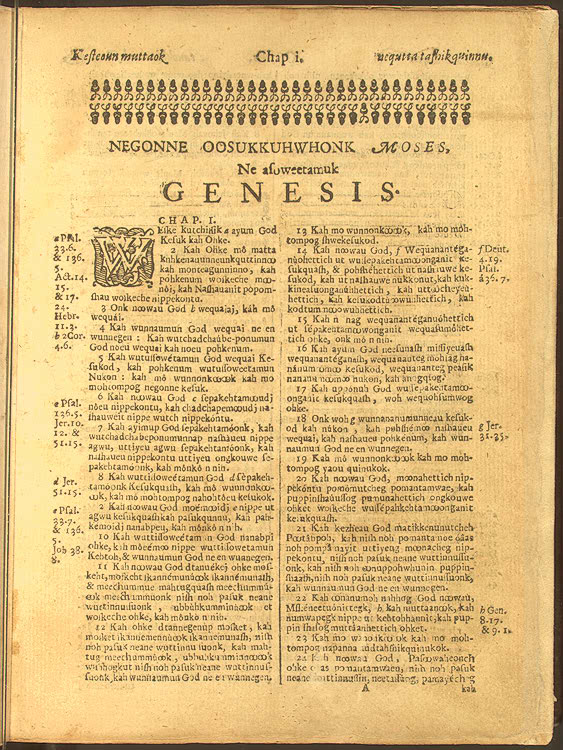Study Guide Island Christianity

Table of Contents
Eliot Bible
The most central book for the Wampanoag and white religious communities on Martha’s Vineyard was the Bible. Puritans laid great importance on individuals being able to read the Bible for themselves. As historian Charles Hambrick-Stowe notes, literacy “destroyed the exclusive spiritual authority and efficacy of the priest….[and] Although the Puritan pastor retained the role of counselor, the printed manual took over some of the functions of the spiritual director of Roman Catholic monastic devotion (Hambrick-Stowe 49). Early on, the Bible favored by the Puritans was the Geneva Bible, though
later the King James Bible became popular. Originally printed in 1560, the
Geneva Bible was an important resource for the layperson: it was the first
Bible to divide scripture into numbered verses, and it offered extensive
marginal notes that helped explain its contents. Importantly it was also
the first English Bible to be directly translated from Hebrew and Greek,
rather than via Latin. John Eliot’s “Indian Bible” Mamusse wunneetupanatamwe (1663) and Experience Mayhew’s Algonquian translation of The Massachuset
psalter (1709) reflect the Geneva Bible’s goal of reaching out to the
common person. Eliot and Mayhew's translations played a key role in island
religious culture and in allowing individuals to read the bible for themselves,
since well into the early eighteenth century, Wôpanâak was the dominant
language for Algonquians even in religious communities on the island (Silverman 369).
Early on, the Bible favored by the Puritans was the Geneva Bible, though
later the King James Bible became popular. Originally printed in 1560, the
Geneva Bible was an important resource for the layperson: it was the first
Bible to divide scripture into numbered verses, and it offered extensive
marginal notes that helped explain its contents. Importantly it was also
the first English Bible to be directly translated from Hebrew and Greek,
rather than via Latin. John Eliot’s “Indian Bible” Mamusse wunneetupanatamwe (1663) and Experience Mayhew’s Algonquian translation of The Massachuset
psalter (1709) reflect the Geneva Bible’s goal of reaching out to the
common person. Eliot and Mayhew's translations played a key role in island
religious culture and in allowing individuals to read the bible for themselves,
since well into the early eighteenth century, Wôpanâak was the dominant
language for Algonquians even in religious communities on the island (Silverman 369).
The Eliot Bible was essential in building and maintaining religious life on the island. In Indian Converts, Mayhew remarks with favor which men and women on Martha’s Vineyard were known for reading the Bible to their families. Island behavior reflected New England practice more generally: “Family devotions consisted chiefly of morning and evening Scripture reading, prayer, and psalm singing, and of thanksgiving at meals. The Bible was read `in course,’ sequentially by chapter from beginning to end, and family members often took turns reading aloud” (Hambrick-Stowe 144). From the missionary perspective, the Eliot Bible was an essential means of making Algonquians into Puritans; however, one might also argue that it helped make Puritanism an Algonquian religion. Translator John Eliot was the minister for Natick, one of the key Algonquian praying towns that lay west of Boston. Unlike Mayhew who grew up speaking Wôpanâak, Eliot came to speak Massachusett as an adult, and remained a marginal speaker. Consequently, Eliot’s translations were a bicultural phenomenon, done with the aide of Massachusett minister John Sassamon who helped with the translation, and Algonquian journeyman James Printer, who set the type for later editions. Sassamon was the first Native American to study at Harvard, and would later serve as King Philip’s (Metacomet) teacher and interpreter. In 1675, his “accidental” death by drowning, a result of having crossed Philip, instigated the violence of King Philip’s War (Lepore, The Name of War). Like any translation, the Eliot Bible serves as a bridge between two worlds: it is a product of the language and culture of both the English and Algonquians, of Eliot and Sassamon. For Vineyard Wampanoags, the Eliot Bible offered a means of grasping hold of what Christianity offered through a more familiar lens.
Items Related to the Eliot Bible in the Archive
Sacraments < Previous | Next > Biblical Marginalia